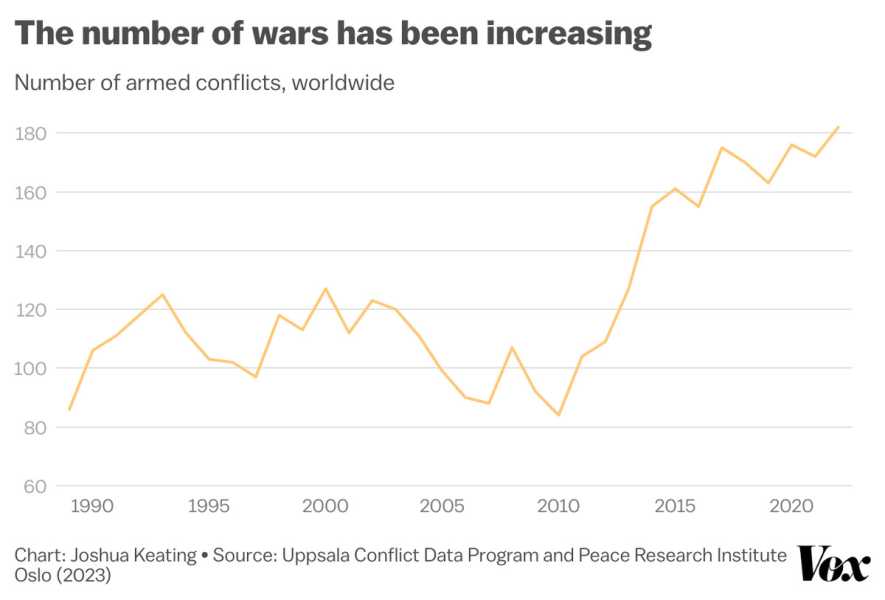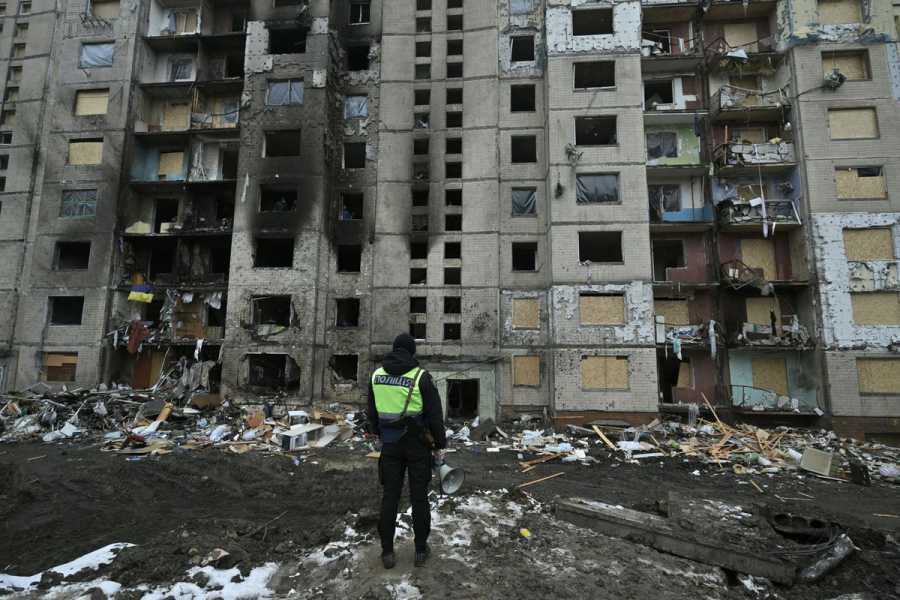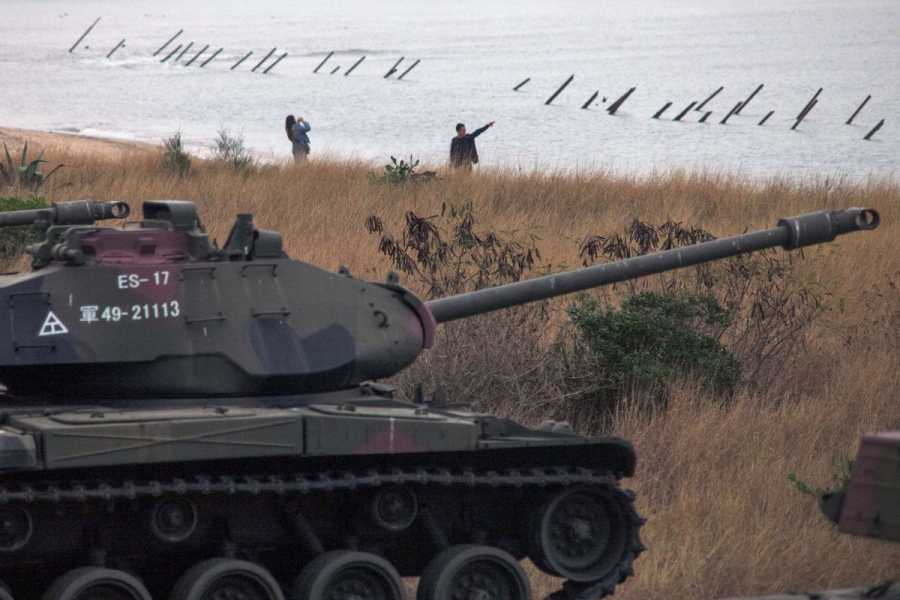Why the “long peace” may be ending.

An Israeli soldier in northern Gaza on January 7, 2024. Noam Galai/Getty Images Joshua Keating is a senior correspondent at Vox covering foreign policy and world news with a focus on the future of international conflict. He is the author of the 2018 book, Invisible Countries: Journeys to the Edge of Nationhood, an exploration of border conflicts, unrecognized countries, and changes to the world map.
Is the world becoming more violent, or does it just seem that way?
Yes, the gruesome scenes from Gaza and Ukraine, not to mention less-covered but still deadly conflicts from Myanmar to Sudan to Haiti, paint a picture of a world on fire. Yes, we just experienced a moment when a country with nuclear weapons (Pakistan) was hit by a missile strike from a bordering country (Iran). But it’s also true that media coverage of deadly global events can obscure more positive long-term global trends.
Until recently, there was a good case to be made that we were living through just such a trend. The period since the end of World War II has been referred to as the “long peace” for the historically anomalous absence of interstate war. And this wasn’t just a fortunate accident — around a decade ago, books such as Harvard psychologist Stephen Pinker’s The Better Angels of Our Nature and international relations scholar Joshua Goldstein’s Winning the War on War argued that traditional armed conflict was becoming obsolete.
For Americans, the first decade of the 21st century may have been dominated by the 9/11 attacks and the bloody and controversial wars in Iraq and Afghanistan, but by some measures, it was one of the most peaceful periods in recorded history, with fewer recorded battlefield deaths than the world had seen in a century. (Even American losses in the war on terror were small compared to the worst of US history — a little more than 7,000 US service members were killed in Iraq and Afghanistan combined, fewer than half the number killed in World War II’s Battle of the Bulge.)
In the decade that followed, due largely to the raging conflict in Syria, the number of civilian and military deaths in state-based conflicts around the world climbed from just over 25,000 in 2011 to just short of 116,000 in 2014, according to data from the Uppsala Conflict Data Program and Peace Research Institute Oslo. But that’s still lower than many years in the 1970s and 1980s, when global totals often exceeded 200,000 annually, let alone the more than 400,000 who died on average per year in the late 1940s. By 2020, the number had fallen back below 54,000.

But the decline in deaths was just one factor — something fundamental seemed to have changed about the nature of war in the post-Cold War era. When wars have happened over the past few decades, they’ve almost always been fought within states, involving nonstate actors like rebel groups or terrorist organizations. While they can certainly be brutal — just look at Syria or the Rwandan genocide, the latter of which cost the lives of some 800,000 people — these conflicts usually don’t involve enough people or firepower to produce casualties on the level of interstate conflicts, meaning wars between two or more countries.
Conflicts on the order of the Napoleonic and French Revolutionary wars of the early 19th century (2.5 million deaths) or the 1980s Iran-Iraq war (as high as 1 million) seemed unthinkable. And the exceptions, like the initial US campaign against Saddam Hussein’s Iraqi regime in 2003 or Russia’s invasion of Georgia in 2008, tended to be brief and fairly one-sided. It was easy to look at the trends and think, as experts like Pinker and Goldstein did, that truly destructive interstate war was a thing of the past — something too irrational to endure in an era of globalization and interconnection.
Lately, however, the picture has looked less promising.
Uppsala’s data shows a dramatic increase in the number of different conflicts around the world starting around 2011 — the year of the Arab Spring uprisings, which led to deadly conflicts in Syria, Libya, and Yemen.

Then came 2022, which, according to Uppsala and PRIO, saw more than 204,000 war deaths. That made it the deadliest year for conflict since the mid-1980s. Russia’s invasion of Ukraine made the biggest headlines: It was the kind of industrialized nation-state versus nation-state conflict, complete with tank assaults and trench warfare and artillery duels, that the world had rarely seen this century.
But it wasn’t even the deadliest war of 2022. That dubious honor went to Ethiopia’s war with separatists in the Tigray region, which led to between 300,000 and 600,000 deaths over the course of two years. Though Uppsala and PRIO haven’t yet released numbers for 2023, it’s unlikely the outlook has improved given the brutal toll in Gaza since October 7 as well as conflicts elsewhere.
“At this point, we can be sure that it’s not just random based just on the numbers we’re seeing,” Magnus Öberg, director of the Uppsala Conflict Data Program, told Vox.
So does the recent uptick in war — both the number of conflicts and how deadly they are — suggest that the long peace is over and that war is making a comeback? And if so, why?
The challenge is that understanding why the world seems to be getting more violent requires understanding why it had been getting more peaceful — and there’s little consensus there. (In fact, some scholars have argued that conflict didn’t decline at all, and that the long peace thesis is based on cherry-picked data.)
But there are a number of plausible explanations for both war’s earlier decline and why that decline may be reversing.
War doesn’t pay
One simple suggestion for the long peace: War isn’t worth it. Thanks to global supply chains and increasing economic interconnectedness, any benefits of war are outweighed by the costs of disruption. The most famous expression of this so-called “capitalist peace” idea is New York Times columnist Thomas Friedman’s “Golden Arches Theory,” which holds that “No two countries that both have a McDonald’s have ever fought a war against each other.”
While it made some sense when Friedman formulated it in 1996, the rule has been violated many times since — and never more clearly than in Russia’s invasion of Ukraine, two countries that, yes, both had McDonald’s. If Russian President Vladimir Putin hadn’t made the decision to invade in 2022, there’s no reason to think European countries wouldn’t still be buying Russian gas at the same or even increased rates via either a vast network of pipelines that crosses Ukraine itself or the newly constructed Nord Stream pipeline. The war has cost Russia dearly in trade, investment, and squandered opportunities for economic development, not to mention the lives of more than 40,000 of its soldiers.

A police officer stands in front of a heavily damaged residential building three days after a Russian missile attack in Kyiv, on January 5, 2024. Genya Savilov/AFP via Getty Images
Putin’s willingness to put territorial ambitions and security interests (as he perceives them) ahead of dollars-and-cents calculations is a stark warning for those who suggest, for example, that Taiwan’s indispensable role in global semiconductor production would make an invasion too expensive for China to attempt. And rather than acting as a deterrent to war, the global financial system has just as often become another forum for conflict, one in which countries use sanctions, export controls, and other means to inflict pain on one another — a practice known as “weaponized interdependence.”
The global cop is off the beat
Some scholars, notably the neoconservative writer Robert Kagan, have emphasized the role of US foreign policy — and particularly US military power — in upholding the “rules-based international order” that underpinned the long peace. Increasingly isolationist tendencies in American politics over the last several years, the argument goes, are chiefly responsible for causing increasing global instability. Former NATO Secretary General Anders Fogh Rasmussen articulated a version of this critique last week, telling Politico that “recent global events in the Taiwan Strait, in the Middle East, in Ukraine are all results of American hesitance to actually lead.”
There really is an increasing willingness on both the left and right in American politics to reconsider US military commitments after two decades of the war on terror, as seen most dramatically in the controversial withdrawal of US troops from Afghanistan, which began under former President Donald Trump and concluded under President Joe Biden. Still, the benefits of what’s been referred to as Pax Americana can be overstated. There’s a good case to be made that US interventions in Iraq and Libya are the cause of or at least a contributing factor to ongoing instability in the Middle East and North Africa. And for all the talk of US decline and the emergence of a multipolar world, America’s military resources and its centrality to the global financial system are still mostly unmatched. When global demands were growing for a military coalition to protect Red Sea shipping from the Houthis in Yemen, there wasn’t much question about which country would lead it.
But it is true that we live in a world where US primacy is increasingly challenged by nuclear-armed powers like Russia and China, the latter of which now has the world’s largest military in terms of manpower and is arming up at a rapid pace. The upshot of such a renewed period of great power rivalry, notes Uppsala’s Öberg, is that “we tend to see many more proxy wars.”
Then there’s the role of increasingly assertive “middle powers.” Consider the “Axis of Resistance” groups Iran uses to project power throughout the Middle East, or Turkey’s involvement in the conflict in Libya, or how Saudi Arabia and the United Arab Emirates have become entangled in the conflict in Sudan. This can intensify war because outside patrons keep belligerents on the battlefield longer, prolonging conflicts.
Eroding norms
One simple but counterintuitive argument for the decline of war, or at least interstate war, is that war is technically illegal. The UN Charter forbids “the threat or use of force against the territorial integrity or political independence of any state.” Even if the rule has frequently been violated in the years since the UN’s founding, it’s true that wars of territorial conquest have become far more rare than they were before 1945. (When Russia first annexed Crimea in 2014, then-US Secretary of State John Kerry accused the country of behaving in a “19th-century fashion.”)
When countries do use or threaten to use force against one another, they generally at least pay lip service to international law in order to justify their actions. Tellingly, in announcing the start of his “special military operation” in Ukraine, Putin invoked the UN Charter’s right to “individual or collective self-defense,” arguing that he was acting to protect the rights of Russian speakers in eastern Ukraine. Notably, he cited US interventions in Iraq, Libya, and Syria as precedent.
That wasn’t accidental. Oona Hathaway, a Yale University professor of international law, told Vox that the US has inadvertently undermined the rules-based order that it helped build and protect. “The US really led the way in pioneering this idea that states can use military force against nonstate actors located in the territory of other states, and they can do so without the consent of the state,” Hathaway told Vox.
It’s hard to believe now, but there was a time when Sen. John McCain, who was no one’s idea of a dove, argued that pursuing Osama bin Laden in Pakistani territory would violate that country’s sovereignty. Today, the idea of attacking an armed group on another country’s territory has been more or less normalized, as shown by the recent Iran-Pakistan skirmish.
Nuclear nightmares
There’s also the ironic concept of “nuclear peace”: the idea that the dangers of nuclear war are so great that major powers deliberately skirt conflict in order to avoid catastrophe. For all that his rhetoric has frequently involved nuclear weapons, Putin has not actually come close to deploying them in Ukraine, nor has he used conventional weapons against any of the NATO member countries directly supplying weapons to Ukraine. Putin knows that these countries are bound by a mutual defense treaty to the US and fall under the so-called “nuclear umbrella.” When troops from China and India — two nuclear states with modern militaries — fight over disputed territory in the Himalayas, they deliberately do so with sticks and bricks rather than guns, keeping the risk of escalation minimal.
But Ukraine also shows how nuclear weapons can enable conflict. The fact that Putin controls the world’s largest nuclear arsenal is the chief reason he can be confident his military won’t have to face US and NATO troops on the battlefield. Without that arsenal, it’s reasonable to think the US might have intervened directly to protect Ukraine’s sovereignty from invasion, as it did Kuwait’s in 1990. Even a NATO-imposed “no-fly zone” to protect Ukraine is considered too dangerous precisely because of the unknowable risk that a single Russian warplane downed by NATO fighters might lead to nuclear annihilation.
At the same time, nuclear deterrence may be losing its potency. Ukraine’s experience — it gave up the Soviet nuclear weapons that were left on its territory after independence in exchange for security guarantees from Russia and the US — may convince other countries facing potential invasion threats that they need to maintain nuclear arsenals of their own. China, which has been building its nuclear arsenal, may soon become the third country in the world with more than 1,000 nuclear warheads, complicating Cold War-era models of deterrence and armed control that assumed just two nuclear superpowers. And whatever the reason, Iran — which has been making renewed progress on its own nuclear program — did not appear particularly deterred from launching a missile strike at the territory of nuclear-armed Pakistan earlier this month.
The democratization of destruction
The first attempted lethal strike by a remotely piloted aerial drone took place in Afghanistan in 2001, during the first months of the US war on terror. In the years that followed, drones became one of the primary tools for US counterterrorism, symbolizing the near-omnipotent ability of the United States to strike targets at will, nearly anywhere in the world, all without putting a single one of its service members at risk.

Members of the Sudanese armed popular resistance, which supports the army in the ongoing conflict with paramilitaries, in Gedaref, Sudan, on January 16, 2024. Ebrahim Hamid/AFP via Getty Images
And drone warfare has since gone global. A 2020 New America study found that as of that year, at least 10 countries had conducted drone strikes, and 38 possessed armed drones.
Starting in 2020, the Armenia-Azerbaijan war and Ethiopia’s war in Tigray showed how drones could be used to devastating effect on a conventional battlefield, as opposed to limiting use to counterterrorism operations. And both sophisticated drones supplied by the US and off-the-shelf models rigged to help with surveillance or to drop explosives have been a major factor in the war in Ukraine for both sides.
It’s not only nation-states that have taken advantage. Militant groups have employed large numbers of what one US military commander dubbed “Costco drones” to attack US bases in Iraq and Syria. Mexican drug cartels are increasingly using bomb-dropping drones as well.
And drones aren’t the only military tool that seems to be democratizing. For years, defense analysts have been debating whether China’s military would be capable of using ballistic missiles — which fly higher and faster than cruise missiles and are more difficult to intercept — to target ships in a potential war with the United States, something that had never actually been done in a combat setting. In December, Houthi rebels targeting shipping in the Red Sea went ahead and did it. This week, Mexico’s government called for an investigation into how military-grade US weapons, including grenade and rocket launchers, ended up in the hands of cartels.
The bottom line is that more actors — from small, poor countries to nonstate militant groups — now have access to the sort of capabilities that were once reserved for superpowers.
Crime: The wars below the surface
One criticism of the decline of war thesis has been that it leaves out a large portion of the world’s armed conflict, which is carried out by groups that don’t wear uniforms and don’t have an explicitly political agenda.
For instance, the signing of a peace agreement between the Colombian government and the country’s left-wing FARC rebels in 2016 ended more than half a century of brutal fighting and brought some excited headlines touting the fact that there were now no ongoing wars of any kind in the entire Western Hemisphere. The last time two countries in the region went to war with each other was the short-lived Soccer War between El Salvador and Honduras in 1969.
Yet of the 10 countries with the world’s highest homicide rates, eight are in Latin America or the Caribbean, according to the UN Office on Drugs and Crime. Criminal organizations and drug cartels can pose as much of a threat to political order as any politically motivated rebel group, as shown earlier this month in Ecuador, where armed gangs attacked key sites throughout the country. The chaos caused by gang violence in Haiti has become sufficiently dire that a UN-organized peacekeeping force is in the works. Warlike levels of violence are one of the main drivers of the region’s high-levels of mass migration as well.
None of this is war, in the traditional sense, but neither is it peace.
Is war back?
Joshua Goldstein, author of Winning the War on War, told Vox that there is “clearly something different going on than what has been [happening] during the post-Cold War era,” but cautioned that it’s too soon to say whether it’s a “long-term or a short-term reversal.”

Tourists visit the Triangle Fortress on Taiwan’s frontline island of Kinmen on December 6, 2023. Sam Yeh/AFP via Getty Images
Goldstein pointed out that even as new conflicts have emerged in Ukraine, Gaza, and elsewhere, a number of long-running wars have also come to an end. The US withdrew from Afghanistan, ending a two-decade war, in 2021. The conflict in Syria has gone from a raging inferno to a low boil, as the Bashar al-Assad regime has consolidated control over much of the country and has normalized relations with many of the regional powers that were backing armed efforts to overthrow him just a few years ago. An uneasy ceasefire has been held in Yemen for the last two years, a welcome respite in a conflict that has directly killed more than 150,000 as well as far more through disease and malnutrition, although it remains to be seen how long that can last given the Houthis’ recent activities and the international coalition assembled to stop them.
None of the outcomes of these wars are particularly welcome for the United States — or for most of the people in those countries, given which groups and authoritarians ended up in power — but they do show that seemingly intractable conflicts can end even as new ones emerge.
It’s clearly not realistic to think that war will simply disappear. But as grim as the global headlines have been in recent weeks, it’s also misguided to assume that a return to the global carnage of the past is simply inevitable.
Sourse: vox.com